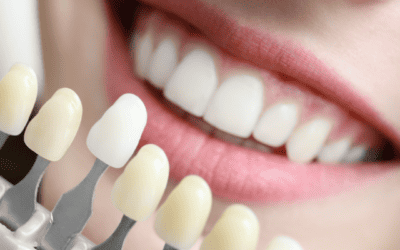A good night’s sleep is important for many aspects of our health and wellbeing:
- Good sleep can boost your cognitive performance and mood
- Poor sleep can increase the risk of poor mental health
- Poor sleep is linked to heart disease, diabetes, obesity and even dementia
For many of us, improving our sleep may be as simple as shutting off the blue light an hour before bed, limiting caffeine in the afternoon, having a wind down routine and going to bed earlier. However, for others it can be more difficult than that.
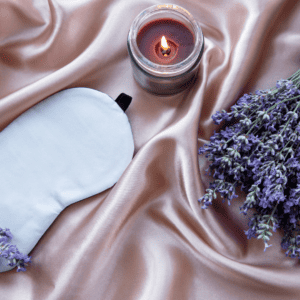
A relaxing bed-time routine can help with sleep
A snoring partner can be very disruptive to the quality and quantity of your sleep. Or perhaps you are doing all of the above and are going to be early, feel like you are sleeping well, but are still tired in the morning. What else can you do?
This blog will talk about the disruptions of snoring and the hidden health impacts of obstructive sleep apnoea (OSA), what you can do about it and how the dentist can help.
What is snoring?
The sound of snoring is caused by soft tissue vibrations at the back of your throat. This happens when air passes past these tissues which are more relaxed and floppier when you are sleeping. Most of us will snore from time to time. A cold can cause a blocked nose and narrower airways, leading to snoring. Alcohol causes the soft tissues to relax even more, causing snoring.
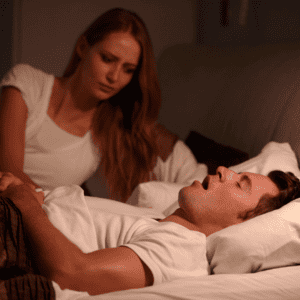
Snoring is one symptom of obstructive sleep apnoea. It’s also very disturbing for bed partners.
However, chronic snoring can be the sign of an underlying issue and can be a problem in and of itself. Snoring is essentially an obstruction. It means that air is not passing freely. If the passage of air stops due to the soft tissues at the back of the throat collapsing and blocking airflow – this is what we call an apnoea. This can happen multiple times per night in those with obstructive sleep apnoea (OSA).
Those that snore do not necessarily have sleep apnoea. However, one of the main symptoms of OSA is snoring.
How Can I reduce my snoring?
- Reduce alcohol – alcohol is a relaxant and will make the soft tissues at the back of the throat even more floppy and increase snoring.
- Try and sleep on your side – gravity while sleeping on your back will cause more soft tissue collapse at the back of your throat. Try a positioning device, or an old-fashioned tennis ball tied into the back of your shirt.
- Aim for a healthy weight – too much excess tissue at the back of our throat will increase snoring and risk of OSA.
What is Obstructive Sleep Apnoea
Sleep apnoea is a very common sleep disorder, and many people don’t even know that they have it. Apnoea means ‘without breath’ and is classified as no airflow for more than 10 seconds. People with sleep apnoea also have hypopnoeas and this is a reduction in airflow by around 50%.
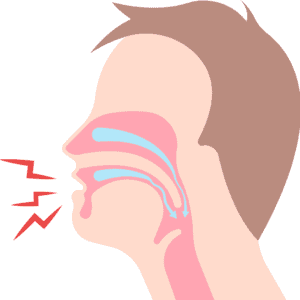
Apnoea means ‘without breath’ and can happen when the soft tissues at the back of the throat narrow and block the airflow
This absence of breath, or reduction in breath, causes the amount of oxygen in the blood to drop, which sets of alarm bells in your brain. Your brain will then wake you from sleep to make you take a breath. Most people are not even aware of these awakenings, as they are so short. However, this fragmented sleep can leave them feeling very tired.
All these little awakening, which can happen anywhere from more than 5 times per hour (mild sleep apnoea) to over 30 times per hour (severe sleep apnoea) not only affects your sleep and your energy levels, but has physiological consequences. When your brain jolts you out of sleep to stimulate you to breathe, it also causes a rise in blood pressure and heart rate. This happening multiple times per hour can lead to other health issues such as cardiovascular disease and increased risk of stroke and heart attack. Untreated sleep apnoea also increases the risk of type 2 diabetes, high blood pressure and abnormal heart rhythms.
What are the other symptoms of Obstructive Sleep Apnoea?
Along with snoring, those with OSA may also experience:
- Excessive daytime sleepiness
- Problems with concentration
- Morning headaches
- Teeth grinding
- Sore throat when wakening in the morning
- Witnessed pauses in breathing during the night and/or gasping/choking during the night
- High blood pressure
If you are worried that you might have OSA, you can carry out a screening questionnaire here
How can the dentist help?
For all of our patients who we are considering helping with their snoring or suspected OSA, we recommend a referral to a sleep physician for a sleep study. Following this, we will present the results to you, along with the recommendation from the sleep physician. They may have recommended a mandibular advancement splint (MAS) or CPAP therapy.
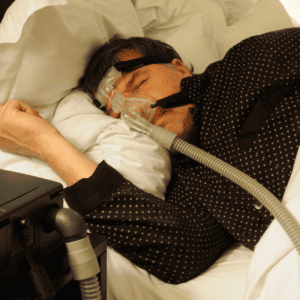
CPAP is one option for obstructive sleep apnoea
What is a mandibular advancement splint?
A MAS is essentially top and bottom mouthguards that work in a way to hold your bottom jaw further forward from it’s natural position during the night while you are sleeping.
As discussed above, snoring is caused by the soft tissues at the back of the throat vibrating. These soft tissues can include the tongue, which can relax and fall backwards while asleep. As the air passes through this narrower gap at the back of the throat, the tissues will vibrate – causing snoring. If the air can’t pass through – we have an apnoea or a hypopnea.
Our tongues are attached to our bottom jaw. Therefore, by pulling the bottom jaw forward, we are pulling the tongue forward too, this can help open the airway. For severe OSA, CPAP is usually recommended. However, those who cannot tolerate CPAP or who have mild or moderate OSA, MAS can be an option.
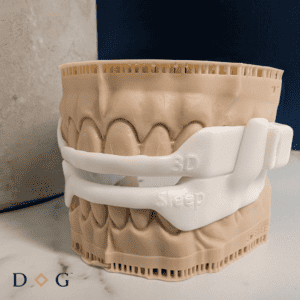
A 3D printed nylon custom-made titratable oral appliance for snoring and/or OSA
However, this treatment is not recommended for everyone who has snoring and/or mild/moderate OSA. For example, if the cause of the snoring/OSA is thought to be from enlarged tonsils, or problems with the sinuses/nose, then referral to an ENT would be more appropriate.
Therefore, each patient is carefully assessed prior to any treatment. We consider your medical, dental and sleep history and will do a thorough exam of your teeth, jaw joints, how the teeth bite together and the health of your gums. Following this consultation, assessment and recommendations from the sleep physician, individual recommendations will be given, along with all the risks, benefits, and side effects.
Benefits of Oral Appliance Therapy
- MAS are easy to wear – it is possible to speak, yawn and drink while wearing it. Although it covers the top and bottom teeth, the two halves of the appliance are separate (not joined together)
- They are custom-made to fit your mouth and the design of the appliance is customized for your individual needs.
- They are titratable, which means they can be adjusted over time to change the position of the lower jaw
- MAS have been shown to have up to 95% success rate in snorers
- A systematic review carried out in 2019 showed a 92% improvement in the symptoms of OSA with the use of a mandibular advancement splint. Other studies show success ranges from 65% – 95%. As mentioned above – everyone is different. Your individual likely success will be discussed by your dentist.
- The appliance is light and great for travelling – it can be used in conjunction with CPAP – for example some patients with CPAP like to have a MAS for travelling.
- Although they are light and comfortable to wear, they are strong and also protect the teeth from the effects of tooth grinding
- If looked after well, it can last for many years
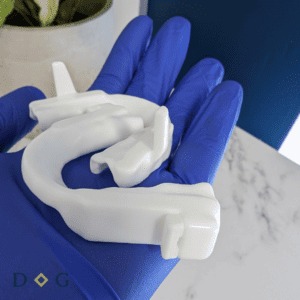
Although thin, light and comfortable to wear, they are strong and will protect the teeth from the effects of tooth grinding
Side Effects of Oral Appliance Therapy
Some side effects are transitory, for example:
- Dry mouth
- Excess salivation
- Tender teeth in the morning
- Tender jaw and jaw muscles on wakening.
More serious side effects include severe pain in the jaw – we would advice you stop wearing the device until we get your symptoms under control.
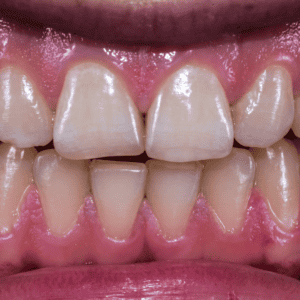
Once side effect could be an alteration in the position of how the teeth bite together
A long-term side effect is movement of the teeth. Your dentist will discuss your individual risk factors with you, and we will give you a morning repositioning device to try and counteract this tooth movement.
Next Steps
If you are worried about your or your partner’s snoring or risk of OSA, please contact us or your GP for a consultation.
A sleep consultation at Dentistry on George includes:
- Taking a thorough medical, dental, social and sleep history
- For new patients to our practice, we will undertake a thorough check of the teeth, gums and soft tissues of the mouth
- We will check your jaw joints and how the teeth bite together
- Any x-rays or photos that are deemed necessary
- If you have a previous sleep study – this will be reviewed with you
Following this, we will make individual recommendations for you.
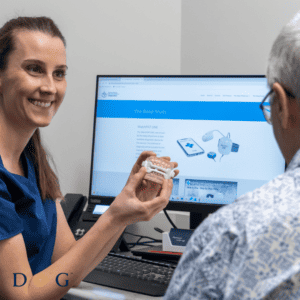
Book in for your comprehensive sleep assessment


